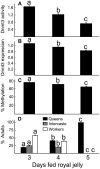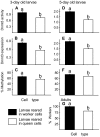Diet and cell size both affect queen-worker differentiation through DNA methylation in honey bees (Apis mellifera, Apidae)
- PMID: 21541319
- PMCID: PMC3082534
- DOI: 10.1371/journal.pone.0018808
Diet and cell size both affect queen-worker differentiation through DNA methylation in honey bees (Apis mellifera, Apidae)
Abstract
Background: Young larvae of the honey bee (Apis mellifera) are totipotent; they can become either queens (reproductives) or workers (largely sterile helpers). DNA methylation has been shown to play an important role in this differentiation. In this study, we examine the contributions of diet and cell size to caste differentiation.
Methodology/principal findings: We measured the activity and gene expression of one key enzyme involved in methylation, Dnmt3; the rates of methylation in the gene dynactin p62; as well as morphological characteristics of adult bees developed either from larvae fed with worker jelly or royal jelly; and larvae raised in either queen or worker cells. We show that both diet type and cell size contributed to the queen-worker differentiation, and that the two factors affected different methylation sites inside the same gene dynactin p62.
Conclusions/significance: We confirm previous findings that Dnmt3 plays a critical role in honey bee caste differentiation. Further, we show for the first time that cell size also plays a role in influencing larval development when diet is kept the same.
Conflict of interest statement
Figures



Similar articles
-
DNA methylation dynamics, metabolic fluxes, gene splicing, and alternative phenotypes in honey bees.Proc Natl Acad Sci U S A. 2012 Mar 27;109(13):4968-73. doi: 10.1073/pnas.1202392109. Epub 2012 Mar 13. Proc Natl Acad Sci U S A. 2012. PMID: 22416128 Free PMC article.
-
Transgenerational accumulation of methylome changes discovered in commercially reared honey bee (Apis mellifera) queens.Insect Biochem Mol Biol. 2020 Dec;127:103476. doi: 10.1016/j.ibmb.2020.103476. Epub 2020 Oct 11. Insect Biochem Mol Biol. 2020. PMID: 33053387
-
H3K4me1 Modification Functions in Caste Differentiation in Honey Bees.Int J Mol Sci. 2023 Mar 25;24(7):6217. doi: 10.3390/ijms24076217. Int J Mol Sci. 2023. PMID: 37047189 Free PMC article.
-
Cytosine modifications in the honey bee (Apis mellifera) worker genome.Front Genet. 2015 Feb 6;6:8. doi: 10.3389/fgene.2015.00008. eCollection 2015. Front Genet. 2015. PMID: 25705215 Free PMC article. Review.
-
Origin and function of the major royal jelly proteins of the honeybee (Apis mellifera) as members of the yellow gene family.Biol Rev Camb Philos Soc. 2014 May;89(2):255-69. doi: 10.1111/brv.12052. Epub 2013 Jul 16. Biol Rev Camb Philos Soc. 2014. PMID: 23855350 Review.
Cited by
-
The dynamic DNA methylation cycle from egg to sperm in the honey bee Apis mellifera.Development. 2014 Jul;141(13):2702-11. doi: 10.1242/dev.110163. Epub 2014 Jun 12. Development. 2014. PMID: 24924193 Free PMC article.
-
Regulation of histone deacetylase 3 by metal cations and 10-hydroxy-2E-decenoic acid: Possible epigenetic mechanisms of queen-worker bee differentiation.PLoS One. 2018 Dec 10;13(12):e0204538. doi: 10.1371/journal.pone.0204538. eCollection 2018. PLoS One. 2018. PMID: 30532259 Free PMC article.
-
Dnmts and Tet target memory-associated genes after appetitive olfactory training in honey bees.Sci Rep. 2015 Nov 4;5:16223. doi: 10.1038/srep16223. Sci Rep. 2015. PMID: 26531238 Free PMC article.
-
Do social insects support Haig's kin theory for the evolution of genomic imprinting?Epigenetics. 2017 Sep;12(9):725-742. doi: 10.1080/15592294.2017.1348445. Epigenetics. 2017. PMID: 28703654 Free PMC article. Review.
-
Analysis of DNA Methylation Differences during the JIII Formation of Bursaphelenchus xylophilus.Curr Issues Mol Biol. 2023 Nov 30;45(12):9656-9673. doi: 10.3390/cimb45120603. Curr Issues Mol Biol. 2023. PMID: 38132449 Free PMC article.
References
-
- Seeley TD. The honey bee colony as a superorganism. American Scientist. 1989;77:546–553.
-
- Winston ML. Biology of the honey bee. Cambridge: Harvard University Press; 1987. 296
-
- Hartfelder K, Tozetto SO, Rachinsky A. Sex-specific developmental profiles of juvenile hormone synthesis in honey bee larvae. Roux's Arch Dev Biol. 1993;202:176–180. - PubMed
-
- Weaver N. Physiology of caste determination. Annu Rev Entomol. 1966;11:79–102. - PubMed
Publication types
MeSH terms
Substances
LinkOut - more resources
Full Text Sources

